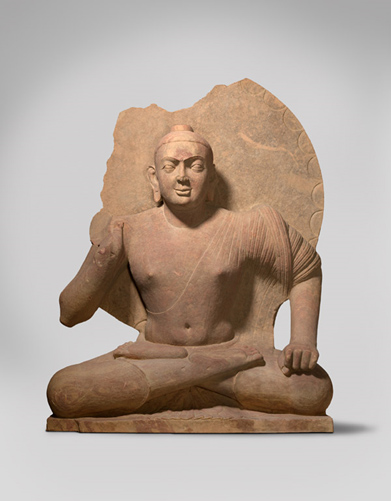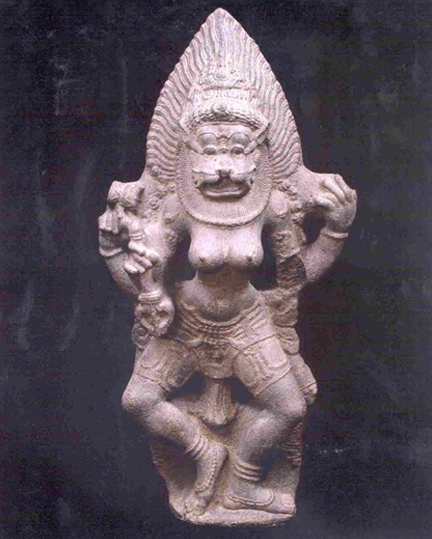The Indian cultural wealth, illegally exported out of the country in the past few years has recently been found to surface in various countries including the USA, UK and Australia. Such art objects are being repatriated from these countries, as and when
it comes to the notice of the Government of India. However, these repatriations got momentum in the recent past at the initiative of the Hon’ble Prime Minister and the Minister of Culture.
National Gallery of Australia (NGA) at Canberra, Australia, which is presently in possession of some illegally exported antiquities of Indian origin, had shown willingness to return these objects to India. Accordingly, a team of Archaeologists from the Archaeological
Survey of India visited NGA on 12th – 13th September, 2015 to examine the objects. The team examined two objects i.e. stone image of Pratyangira from Tamil Nadu and a marble stele showing devotees of Buddha from Andhra Pradesh. Both the objects were found
to be genuine. The stone image of Buddha from Mathura region which was examined by a team from Archaeologist from Archaeological Survey of India in the month of January 2016, was also found to be genuine.
The return of these objects was under process in consultation with Indian High Commission at Canberra. Later on, all three objects were handed over to Minister of Culture of India by NGA, Canberra in a repatriation ceremony held on 19th September, 2016 at NGA,
Canberra. These objects have now finally reached India on 7th December 2016 and are presently kept at the Central Antiquities Collection at Purana Qila, New Delhi.
Ministry of Culture has decided to showcase these three objects at the National Museum, New Delhi. One of these three objects, the Pratyangira image is a case property of Idol Wing of Tamil Nadu Police and it would be handed over to them after a temporary display
at National Museum.
Government of India through its Missions in various countries is monitoring the cases of illegally exported Indian antiquities. The Government hopes that these efforts will help in bringing back the lost cultural property to its place of origin.
The details of the three returned idols are as follows:
1. Seated Buddha Image from Mathura Region:
This image is made up of red sand stone, typically used in sculptures of Mathura region. The image represents a seated Buddha in Abhaya Mudra. The sculpture is complete except for partly broken halo, right palm and also right shoulder. The Buddha is shown seated
in Padmasana wearing ekanshika sanghati. He is shown with an urna, elongated ear-lobs, ushnisha and with a feeling of contemplation on his face. On stylistic ground the image belongs to early Kushana period about last quarter of first century A.D.

2. Buddhist panel from Amaravati region:
This architectural piece adorning a stupa (possibly a drum slab) is made of limestone and is 96.5x106.7x 12.7cm in dimension. The panel depicts the worship of some Buddhist symbol (possibly a chaitya vriksha, but not visible as the piece is much broken at top)
kept on a throne, below which Buddha pada are visible. This central object is flanked by a worshiper couple on either side. On both the sides first representations are of male worshippers who are followed by females. The most probable objects held in their
hand are vases with flowers or garlands as offering objects. The sculpture is a remarkable example of Andhra School of Sculptural art and belongs to circa third century AD during the Satavahana regime in that area. This was unearthed in 1970s during the excavation
of a Buddhist stupa at Chandavaram (District. Prakasham) in Andhra Pradesh.

3. Pratyangira Image from Tamil Nadu:
This image of 125.1x55.9x30.5 cm dimension is made of grey colored granite stone. The image is complete except for the chopped lower left hand. The deity represented is a Tantric deity who is the female aspect of God Narsimha, also known as Narasimhi. She is
evoked in the Sadhanamala also. She has the face of a roaring and furious lion while the body is of a female. Flames are shown coming out of her head. The sculpture is a remarkable example of later Chola art and belongs to circa thirteenth century. The image
was under worship in Vriddhachalam temple near Chennai before its theft.

New Delhi
January 16, 2017
Click here for Malayalam version Click here for Tamil version
Click here for Tamil version Click here for Bengali version
Click here for Bengali version Click here for Telugu version
Click here for Telugu version